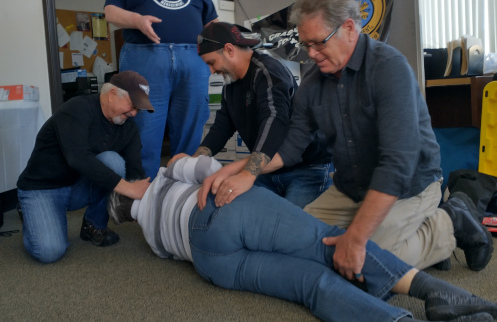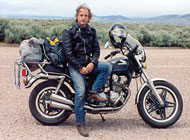Safety Is First At A Crash Scene

Rolling the victim to slip something under them to slide them to safety. Note the attention to stabilizing the head and neck.
If your buddy goes down or you just happen upon a crash scene, and you’re the first one there, the number one thing you need to do is make sure no one–including yourself–suffers further injury.
I recently attended an “Accident Scene Management” class and all this information comes from that.
The first person you’ve got to take care of is yourself. You’re not going to help matters at all if you get hit by a passing vehicle and end up needing assistance yourself. So park safely, with your flashers on, and then go to assist. When you park be sure to leave room for emergency vehicles when they arrive. If there are other people in your group, designate the one with the most training or experience to be in charge. If you have flares or lights or anything to catch attention, deploy those things.
If there’s more than just you you’re going to want to control traffic. Station someone at least 100 feet up the road in each direction, and if you’re at a curve make sure that person is around the curve enough to alert other drivers before they come screaming along. Same with a hill. In town, have them go to the two intersections ahead and behind.
The next part of the training talks about protecting yourself from disease transmission. They say to put on gloves and a face mask. If you’re on your bike you’ll probably already have gloves and helmet on so it would make sense to leave those on. Frankly though, if I see someone bleeding profusely I doubt I’m going to take the time to struggle to slip on some latex gloves.
We’re proceeding now in terms of a motorcycle crash. If the bike is laying on the person you first want to get it off. Besides the weight of the bike and the injury that can cause, they might have their leg pinned against the blazing hot exhaust pipe. Get that thing off them. I won’t waste space here telling you how to lift a bike; you should already know how to do that.
Do you move the person? That depends on potential danger. If you move them there is the possibility you will cause further injury. But if they’re in the middle of the road and you’re the only one there and there is traffic on the road you’ve got to get them off the road. Be aware that every state has “Good Samaritan” laws so don’t worry about being sued for trying to be helpful. But if you don’t absolutely have to move them, don’t. Emphatically, don’t.
If you do have to move them, your method will depend on how many others are there to assist. If you’re alone, reach under from next to the head, grab them by the armpits, cradle their head and neck with your forearms, and pull. If you have assistance you can support their head and neck and roll them over enough to slip a blanket or something under them and them pull on the blanket. The blanket makes it slipperier. The key is to support the head and neck and try not to move the spine. That’s the really big thing, the spine. And that’s why it’s best not to move them at all unless you have to.
Especially if you’re the only one there and you have to leave to get help you will want to–if it’s safe–put them into a position so if they puke–a definite possibility–they don’t suffocate themselves doing so. You’ll want to roll them onto their side with an arm under the head and one leg extended as a “kick stand.” With the person facing downward, any puke will pour out their mouth rather than filling their throat and suffocating them.
Obviously, all these movements are based on your assessments of the situation. If the person is conscious and can talk and they’re moving themselves you have a lot more assurance that the neck and spine are not at issue so you can be freer in what you do. If they’re unconscious you just have to do what seems to make the most sense.
There’s a lot more and I’ll get into that in my next post.
Biker Quote for Today
I got a motorcycle for my wife last week. Best. Trade. Ever!
Tags: accident scene management, crash scene management, motorcycle accidents, Road Guardians
